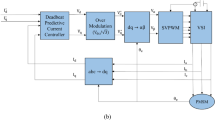Abstract
Results of an investigation of cogging torque in permanent magnet synchronous machines with fractional slot windings are given, and the nature of their origin is considered. This research is important because of the necessity to assess cogging torque at the stage of design of machines developed for areas of application in which there are rigid requirements for noise and vibration level. To simplify the solution, the design of an electrical machine with radial location of magnets is chosen as am object of research. A formula of cogging torque determined as the result of interaction between magnetic field harmonics and corresponding harmonics of the surface current density is developed. Conditions required for cogging torque are determined. Equations for calculating the number of air gap permeance harmonics and magnetomotive force harmonics contributing to the generation of this cogging torque are presented. This study shows that the cogging torque has two components. The first component is the result of interaction of permeance and magnetic field harmonics having the same number; the second component is caused by interaction between the permeance harmonics and mixed harmonics of the magnetic field induced by the stator slotting. An experimental investigation of cogging torque in a machine with 12 slots and 10 poles has been conducted. Fourier analysis of the experimental data verifies the analytical results of experimental data.
Similar content being viewed by others
References
Shevchenko, A.F., Multipole synchronous machines with fractional q < 1 tooth windings and excitation with permanent magnets, Russ. Electr. Eng., 2007, vol. 78, no. 9, p. 451.
Shevchenko, A.F., Komarov, A.V., and Novokreshchenov, O.I., Direct-drive electromechanical steering booster for passenger cars, Russ. Electr. Eng., 2007, no. 9, p. 478.
Geller, B. and Gamata, V., Vysshie garmoniki v asinkhronnykh mashinakh (Higher Harmonics in Induction Machines), Moscow: Energiya, 1981.
Ivanov-Smolenskii, A.V., Elektricheskie mashiny (Electrical Machines), Moscow: Energiya, 1980.
Vol’dek, A.I., The way to research magnetic field in air gap of sailent pole synchronous machines by means of harmonic conductivity, Elektrichestvo, 1966, no. 7, pp. 46–52.
Pristup, A.G. and Toporkov, D.M., Ways for decreasing moment pulsations in magnetoelectric synchronous machine with fractional teeth windings, Izv. Vyssh. Uchebn. Zaved. Elektromekhan., 2013, no. 6, pp. 14–18.
Islam, R. and Husain, I., Permanent-magnet synchronous motor magnet designs with skewing for torque ripple and cogging torque reduction, IEEE Trans. Industry Appl., 2009, vol. 15, no. 1, pp. 152–160.
Jabbari, A. and Shakeri, M., Pole shape optimization of permanent magnet synchronous motors using the reduced basis technique, Iran. J. Electr. Electron. Eng., 2010, vol. 6, no. 1, pp. 48–55.
Author information
Authors and Affiliations
Corresponding author
Additional information
Original Russian Text © A.G. Pristup, D.M. Toporkov, A.F. Shevchenko, 2014, published in Elektrotekhnika, 2014, No. 12, pp. 36–40.
About this article
Cite this article
Pristup, A.G., Toporkov, D.M. & Shevchenko, A.F. A study of cogging torque in permanent magnet synchronous machines with fractional slot windings. Russ. Electr. Engin. 85, 743–747 (2014). https://doi.org/10.3103/S1068371214120128
Received:
Published:
Issue Date:
DOI: https://doi.org/10.3103/S1068371214120128




